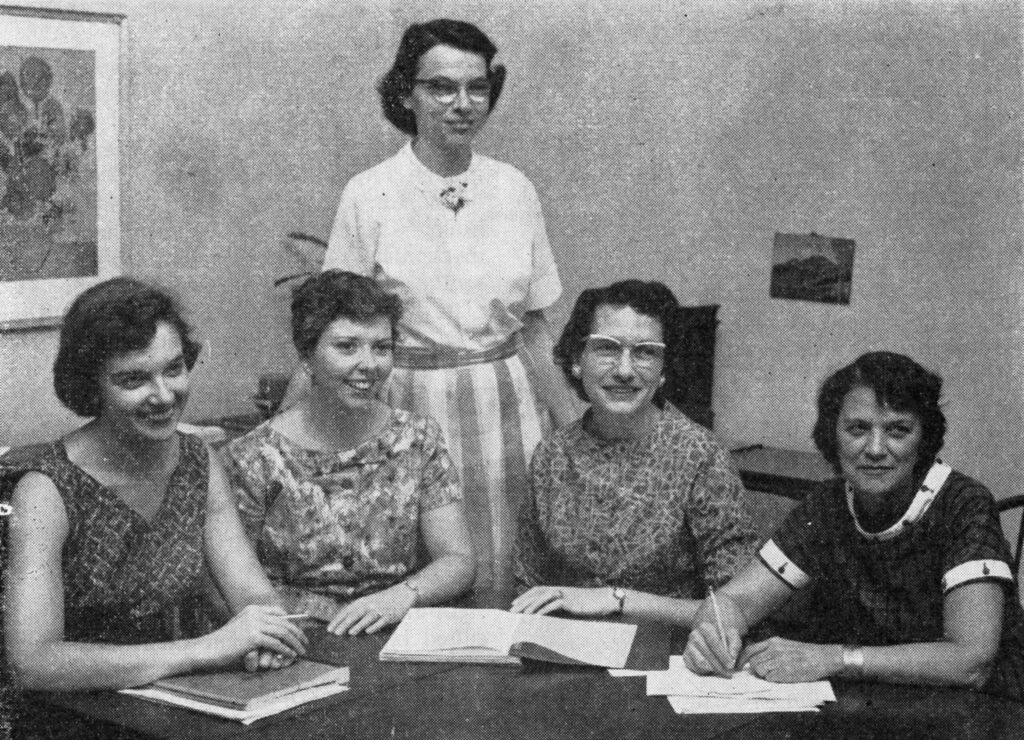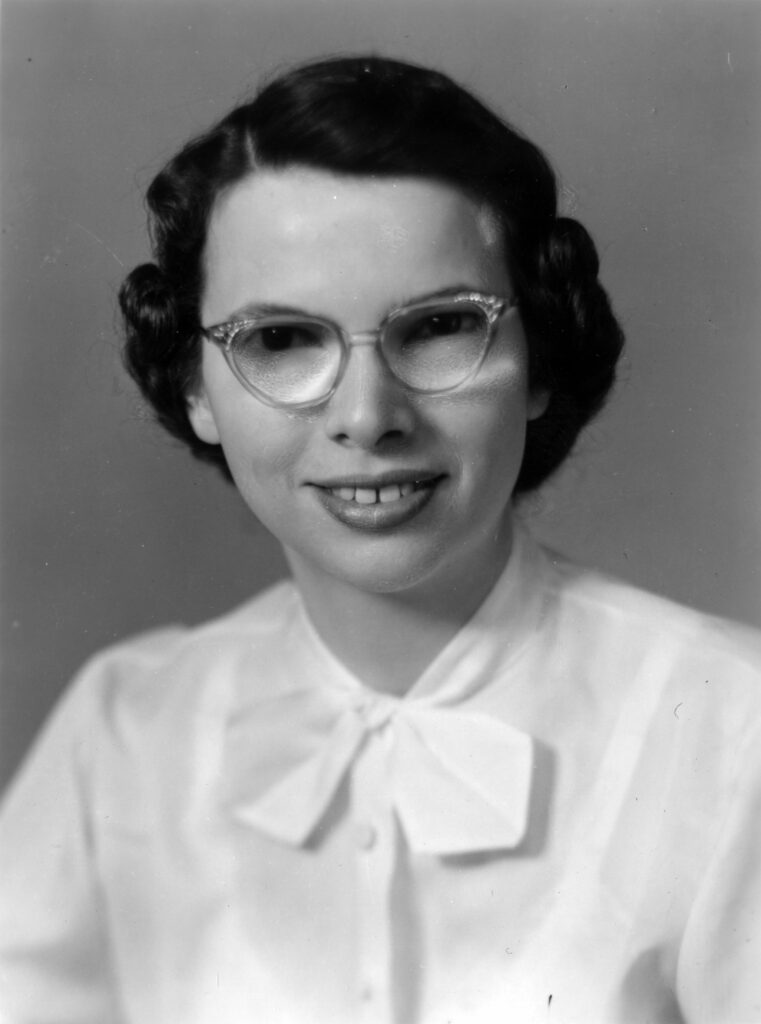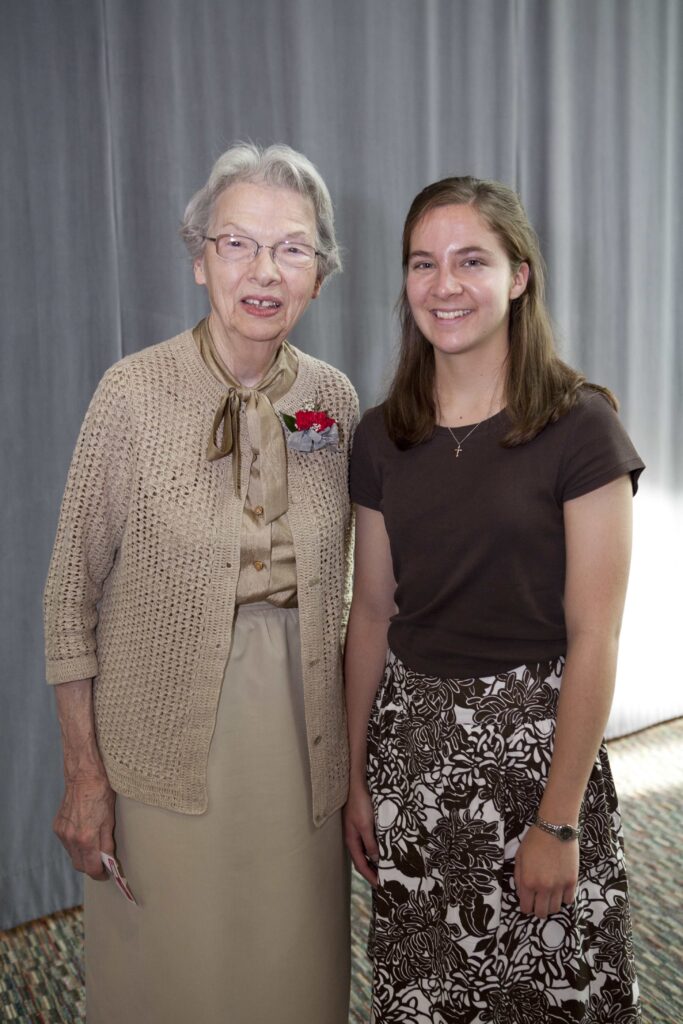It was 1954, the year White Christmas debuted in theaters; the year Elvis launched his legendary career; the year Woody Hayes led the Buckeyes to their second national championship; and the year now Faculty Emerita Fern Ensminger Hunt made her first donation to her alma mater, Ohio State.
Then, Hunt was a new master’s alumna of what is now the College of Education and Human Ecology and had a desire to pay forward. She and her now late husband David, a fellow alum, gave their first donation of $6 to the university. That modest, initial gift was the launch of giving that has now stretched across seven decades.
The longevity of Hunt’s giving is remarkable, but what makes it even more impressive is its consistency. With 70 consecutive years of giving, she has one of the longest consecutive giving records at Ohio State. How firm thy friendship, indeed.

Through gifts of various sizes, Hunt’s commitment has never wavered. The impetus for this unbreakable thread of gifts stems from a desire to do right and from a life uniquely interwoven with Ohio State.
At the age of 97 and with three Ohio State degrees to her name — ’48 BS, ’54 MS, ’65 PhD — few who are still living have as long a history of giving with the university as Hunt. She met the man she would marry here. She served as a professor in what was then the university’s School of Home Economics here, and she continued in that role until her retirement in 1988.
Today, she continues as faculty emerita of the college.
A world-class education that launched her career
Hunt, who majored in human nutrition and food, originally chose to study at Ohio State for a simple reason: it was an outstanding and affordable university. “You can’t beat that combination,” she said.

From her undergraduate years, she recalls the tremendous school spirit she felt as part of the university. Most of all, she enjoyed her classes and her professors, the football games, which were “thrilling” and (equally important to her) inexpensive at about 50 cents a ticket.
Affordability was key because Hunt came from humble beginnings. “My parents were very poor and weren’t able to help us much financially,” she said, “but they were very insistent that we get an education.” One of 10 children growing up in her farm family in rural Perry County — “not a very rich place,” as she describes it — Hunt took her parents’ guidance to heart. So did four of her brothers. She was never alone at Ohio State.
Hunt’s bachelor’s degree landed her a job with a northeastern Ohio utility company as a home appliance representative. “Back in the ’40s and ’50s, new appliances, such as food freezers and automatic washers, were proliferating, and women didn’t know how to use them,” Hunt said. Her service impacted entire families as she showed them how to use the latest features to best effect.
Thirst for knowledge leads back to Campbell Hall
Hunt returned to Ohio State to expand her expertise. “I had a goal of working for one of the food companies because I was really interested in food development,” she said. “You needed a master’s for that as well as the utility company experience.”
With Professor Mary Eloise Green as her advisor, Hunt earned that degree and got to work with Green and more faculty once she joined them. In 2002, Hunt interviewed Green for a project with the university’s Archives, capturing details about the early days of Ohio State. Green — who lived to be 102 — shared about her time in Campbell Hall and the home economics program.
With her degree in hand, Hunt accepted an offer to be a Campbell Hall nutrition research assistant. By then, she had met her future husband, David. The double opportunities were, in her words, too good to resist.
Every day, from 1954 until 1965, Hunt entered her office on Campbell Hall’s third floor and the nutrition lab overlooking Neil Avenue. She did essential work for faculty conducting pioneering work in nutrient metabolism.
For Professor Mary Brown Patton, Hunt analyzed how women of college age metabolized different sources of calcium supplements. The study was to help determine best supplements for women of that age who were pregnant.
For Professor Virginia Vivian, she measured nitrogen levels in different diets to determine how changes in amino acid balances influenced available nitrogen from protein.
Hunt has many memories of her time spent in Campbell Hall. “I remember one time my lab project blew up,” she said.
She was working on one of Vivian’s nitrogen analyses, “and someone forgot to put the stabilizer in the open digester container,” she said. The stabilizer prevents explosions when the digester contents are heated.
“The caustic solution, nitric acid, flew all over the place,” Hunt said. “We had to quickly get water on ourselves.” Fortunately, no one was hurt, and Campbell Hall remained intact.
That mishap aside, Hunt’s lab work made valuable contributions, helping faculty publish dozens of research articles that added to the scientific knowledge.
Research for the PhD in food and nutrition, faculty role
Ever hungry to expand her own knowledge, Hunt began taking doctoral-level courses while working. Her dissertation research surveyed Ohioans to see how they handled and stored what were relatively new commercially frozen foods. In the lab, she also studied survival of bacteria in those foods when they were frozen or stored differently.
Her dissertation findings from 2,844 mailed surveys and 335 interviews, as well as her lab studies about bacteria, can still be viewed.
Hunt’s initiation as School of Home Economics faculty, Department of Family Resource Management, arrived in autumn 1966. Over the years, she advanced steadily as she taught classes, including Ohio State Extension workshops, advised graduate students, conducted research, published in prestigious journals and books and contributed to national organizations such as the American Home Economics Association.
In 1973, she received the Major Appliance Consumer Action Panel Research Award. Later, she became full professor and even served twice as acting department chair.
Hunt, her colleagues and students studied topics ranging from how to save energy during food preparation to comparison of plastics and porcelain enamel in home appliances to what consumers want in microwave ovens.
At the height of her career, Hunt was elected to the Board of Trustees of Underwriters Laboratory and was re-elected twice, serving for a total of nine years. She also served on its Consumer Council.
UL Solutions, as it’s known today, is a global, independent safety science organization that establishes standards for a variety of consumer products. “These range from the uniform sizes of light bulbs and sockets to how much weight a ladder can bear to many more standards in business and industry,” Hunt said. “Things weren’t decided for all time, either. New developments make it necessary to update the standards continually.”
Funding supports research, international work
Hunt found special fulfillment from her international work. In 1983-84, she received support from US AID to conduct research in the Philippines.
“Lucylen Beronilla Ponce and her husband were both working on PhD degrees here at the same time,” Hunt said. “She was my student and head of home economics at a small, rural college in the Philippines. I went there to help her with a study of household use of energy resources.”
In Ponce’s 1981 dissertation, search for Lucylen Ponce, she extends deep appreciation for Hunt’s “guidance, inspiration, patience, and ‘being available always.’”
Hunt also had funding from the Ohio Agricultural Research and Development Center, plus added support from several organizations. Her study of home use of frozen foods was funded in part by a grant from the National Association of Frozen Food Packers.
Another study of how to manage home electricity use during peak periods, a time when meal preparation is usually underway, was funded in part by a grant from the Ohio Farm and Home Electrification Council.
Endowed funds commemorate family, fund students in perpetuity
Hunt never underestimated the value of education. And she never forgot the importance of giving people from economically challenged backgrounds access to a world-class place to learn.

One of the first endowed funds she established as a donor to Ohio State, the David S. Hunt Scholarship Fund, is for students from Tuscarawas County. It recognizes her late husband.
Additionally, she established the Charles and Mary Ensminger Scholarship Fund to honor her parents, with preference given to students from her home of Perry County.
Today, Hunt encourages the next generation to save, invest and give back. “I’ve been trying to get some of my nieces and nephews interested in making regular investments,” she said. “It doesn’t have to be a lot at a time. Even small, regular gifts add up.”
Her philanthropic example and wisdom ring with extra meaning these days. In our world of constantly competing priorities and pressing distractions, Hunt’s unshakeable generosity and faithful commitment as a Buckeye for life is remarkable.
“Mom had two goals for us children,” Hunt said. “One, she wanted us all to get an education, and two, she wanted us to do right. “I think we met her expectations.”
The college and Ohio State celebrate Hunt’s devotion, a testament to the power of relationships and the simple joy taken from ties that bind.

